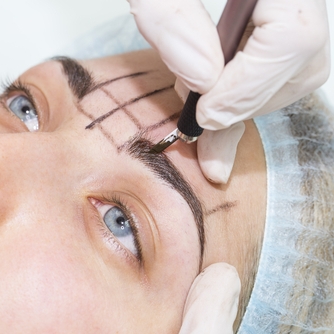
Would you like natural, flawless, and fuller looking eyebrows? What if I told you they could stay that way for up to 18 months or more?
If you said yes, then let me introduce you to microblading. Microblading, also called eyebrow embroidery, is a new and exciting technique, where thin hair strokes are created by using a superfine row of needles, Bella, is a master certified microblading expert and uses the PHIBROW technique. The result is very full and natural looking eyebrows, regardless of how much hair was present. Microblading is perfect for those who want to fully reconstruct, define, cover gaps, or fill-in over plucked brows. It is considered semi-permanent, compared to tattooing techniques used in permanent makeup, lasting 11 to 18 months, or longer in some cases.
It is done using a very fine blade to deposit pigments into the epidermis. Because we’re impacting color closer to the surface, the strokes appear crisp and very fine. There is no “spilling” under the skin. This method is ideal for anyone wanting to enhance the look of their eyebrows. The pigments used in this method are formulated to match your original eyebrow color, and if the eyebrows are still present, blend perfectly into them.

People suffering from alopecia, trichotillomania or any other condition that causes hair loss benefit greatly from Microblading, as well as people who simply aren’t happy with their eyebrows.
The process involves an initial session, with one or more follow up sessions. Immediately after the first session, the brows appear darker, but fade significantly over a two week period. It is absolutely crucial to have a touch up done, as it is very difficult to predict how well the skin will retain the pigment. Touch ups are also recommended one per year to maintain the shape and saturation of pigment.
Microblading Preparation
Pre-treatment instructions are provided below- Avoid caffeine 24 hours of procedure.
- Restrain from alcoholic beverages 24 hours prior to procedure.
- Aspirin, Advil, Motrin, Ibuprofen or any similar pain reliever should not be used 7 days prior to procedure.
- Tweezing or waxing should be done 48 hours prior to procedure.
- Do not expose the areas to be treated to the sun or tanning beds for one week prior to procedure.
- Fillers/and or Botox should be done 3 weeks prior to your scheduled procedure or done 3 weeks after the procedure.
- Arrive for the procedure with a clean, dry face, and free of any products and makeup.
- Consult with your physician before taking or discontinuing the use of any medications.
- If is recommended to NOT have a tan/burn on your dace at the time of the procedure.
- No eyebrow tinting 5 days before the procedure.
- Botox injections should be performed either 2 months prior to your scheduled procedure or 1 month after your final procedure.
Microblading Preparation
Pre-treatment instructions are provided below- Avoid caffeine 24 hours of procedure.
- Restrain from alcoholic beverages 24 hours prior to procedure.
- Aspirin, Advil, Motrin, Ibuprofen or any similar pain reliever should not be used 7 days prior to procedure.
- Tweezing or waxing should be done 48 hours prior to procedure.
- Do not expose the areas to be treated to the sun or tanning beds for one week prior to procedure.
- Fillers/and or Botox should be done 3 weeks prior to your scheduled procedure or done 3 weeks after the procedure.
- Arrive for the procedure with a clean, dry face, and free of any products and makeup.
- Consult with your physician before taking or discontinuing the use of any medications.
- If is recommended to NOT have a tan/burn on your dace at the time of the procedure.
- No eyebrow tinting 5 days before the procedure.
- Botox injections should be performed either 2 months prior to your scheduled procedure or 1 month after your service.
Semi-permanent and Permanent Makeup is NOT recommended for any clients who are or have:
- Women who are pregnant or breastfeeding
- People who have had BOTOX or other injection less than 3 weeks prior to treatment
- Diabetics
- Use Accutane in the last year
- Psoriasis near the area to be treated
- Epilepsy
- Had an organ transplant
- Viral Infections or Diseases
- Heart Problems or a Pacemaker
- Someone who has undergone chemo is last year
- Has rosacea, eczema, or dermatitis in the Eyebrow area active acne and Eyebrow area
- Someone taking blood thinners for heart conditions
- Any Autoimmune disease

